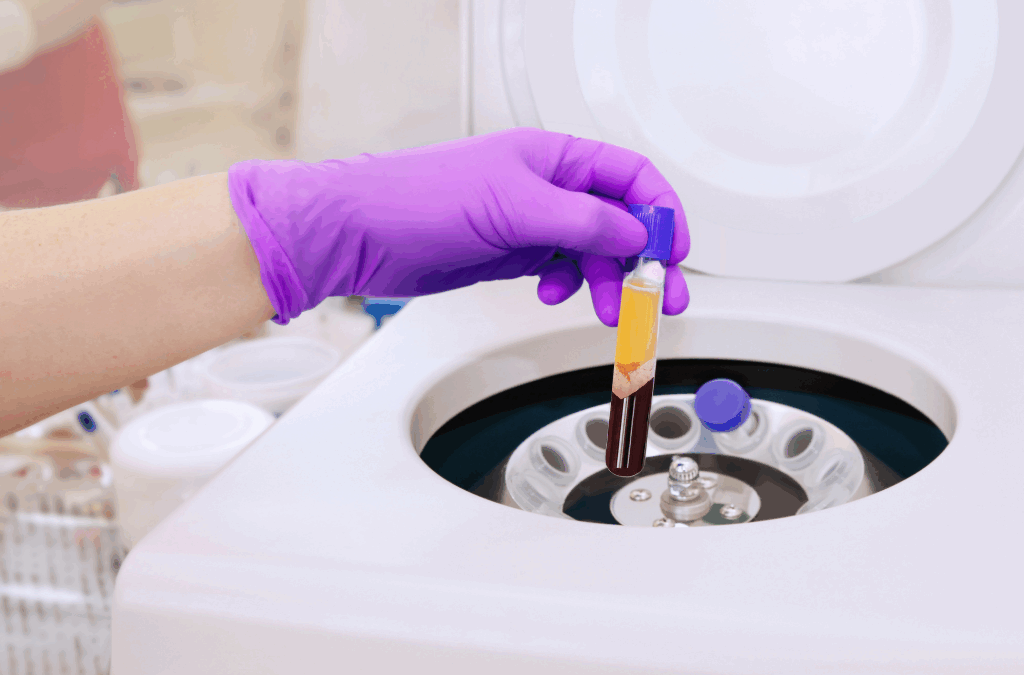Key Takeaways
- PRP packs your own growth factors into stubborn tendons, restarting collagen repair where blood flow is scarce.
- Clinical trials show PRP eases Achilles, patellar, and elbow tendon pain longer than steroid injections.
- Active people who haven’t improved with rest, NSAIDs, or standard rehab often avoid surgery and return sooner after PRP.
Chronic tendonitis hangs around long after the first sharp twinge. The tendon feels sore in the morning, warms up after a few minutes, and then throbs again that night. Ice, rest, and anti-inflammatories help, until they don’t. What you need is actual repair inside the tissue. Platelet-rich plasma (PRP) pushes healing forward by concentrating your own growth factors and placing them exactly where the tendon has stalled.
What Chronic Tendonitis Is and Why It Lingers
Chronic tendonitis means the tendon has stayed painful for more than three months. By this point the problem is less “-itis” (inflammation) and more “-osis” (degeneration). Repeated micro-tears scramble collagen fibers, much like frayed rope. Common trouble spots are the Achilles, patellar, rotator-cuff, and tennis- or golfer’s-elbow tendons.
Several things keep the cycle going:
- High, repetitive loads, think distance running, pickleball serves, or long hours on a computer mouse.
- Poor mechanics or weak supporting muscles that shift stress to the tendon.
- Age-related changes that thin the tendon’s blood supply.
Because tendons receive little direct circulation, their repair crews arrive late and in small numbers. That is why lingering pain is so common.
Why Tendons Heal Slowly
Muscles carry rich networks of capillaries. Tendons do not. They rely on diffusion for nutrients, and that takes time. Each step of healing, breaking down damaged fibers, laying new collagen, lining those fibers up, grinds along at a frustrating pace. If loading continues (most of us still need to walk, work, or train), the damage often outruns the repair.
What is PRP
PRP starts with a simple blood draw. A centrifuge spins the sample and separates the platelets from red and white cells. Those platelets hold hundreds of growth factors: platelet-derived growth factor (PDGF), transforming growth factor beta (TGF-β), vascular endothelial growth factor (VEGF), and others. The clinician injects this highly concentrated liquid back into the tendon under ultrasound guidance so it reaches the degenerated core.
Because the product comes from you, rejection and allergic reactions are rare. No steroids, no synthetic drugs, just your own biology repackaged.
How PRP Repairs Stubborn Tendons
Once inside the tissue, platelet growth factors switch on several helpful processes:
- Cell recruitment. They signal nearby tendon cells (tenocytes) to move in and start work.
- New collagen production. The tendon lays down stronger type I collagen, replacing weaker type III strands that accumulate during chronic injury.
- Angiogenesis. VEGF creates tiny new blood vessels, feeding the area long after the injection.
- Controlled inflammation. PRP resets the balance from destructive enzymes toward constructive remodeling.
What the Research Says
A 2024 meta-analysis covering eight randomized trials found PRP superior to corticosteroid injections at three and six months for lateral epicondylitis, even though steroids edged out PRP in the first month.
A single-center trial reported significant pain and function gains in patellar tendonitis after multiple PRP injections, beating shockwave therapy in that group of 33 participants.
PMC
The most recent umbrella review, confirmed that PRP outperforms corticosteroids for mid-term pain relief across several tendon sites with minimal adverse events.
PMC
Taken together, the weight of evidence shows meaningful, if not instant, benefits. Results depend on tendon location, injection technique, and post-procedure rehab.
What to Expect Before, During, and After a PRP Injection
Pre-injection assessment. Ultrasound or MRI confirms the diagnosis and maps degenerative areas. You may pause anti-inflammatory medication a few days ahead because NSAIDs blunt platelet function.
The day of the procedure. You sit or lie comfortably while a clinician draws about 30–60 mL of blood. Processing takes 10–15 minutes. Under ultrasound guidance, the platelet concentrate is injected through a fine needle. The whole appointment often ends in under an hour.
First 48 hours. Expect a heavy, bruised feeling. Ice and acetaminophen help, but most providers avoid NSAIDs for two weeks.
Week 1–2. Gentle range-of-motion and isometrics keep the tendon from stiffening.
Week 2–6. Supervised eccentric loading begins. Load increases gradually to remodel collagen in the new, healthier way.
Months 2–6. Full loading resumes. Many athletes report steady improvements through month three with gains lasting at least a year in current studies.
A second or third injection may be planned if progress plateaus. The tendon is re-imaged before each step to guide decisions.
Training and Rehab After PRP
PRP is not a stand-alone cure. The tendon still needs mechanical signals to reorganize fibers along the lines of force. A typical program combines:
- Eccentric exercises (slow controlled lowering) that challenge the tendon without overload.
- Isometric holds early on to reduce pain and maintain strength.
- Manual therapy or soft-tissue massage to free scarred layers.
- Shockwave therapy or dry needling as adjuncts where appropriate.
- Gait or movement analysis to correct poor mechanics that seeded the problem.
- Consistent, progressive loading is the main driver of long-term success.
Who Might Benefit and What to Consider
Good candidates
- Active adults or athletes with more than three months of tendon pain not improved by structured rehab.
- People wanting to delay or avoid surgery.
- Those without bleeding disorders or active infections.
Relative cautions
- Platelet or clotting problems.
- Uncontrolled diabetes or immune compromise.
- Recent steroid injection at the same site (often a six-week wait).
Side effects
- Temporary soreness, swelling, or bruising in 30–50 percent of patients.
- Infection is rare (< 1 percent).
- No evidence of tendon rupture linked to PRP in published trials.
Schedule Your PRP Assessment at Avid Sports Medicine
Chronic tendonitis can feel endless, but it is not hopeless. PRP supplies a focused dose of your body’s own repair molecules right where blood supply falls short. High-quality trials now confirm that this approach often eases pain, improves function, and holds those gains for months or longer, especially when paired with a thoughtful rehab plan.
Ready to see whether PRP could calm your stubborn tendon pain? Book a personalized assessment with the sports-medicine team at Avid Sports Medicine today!

